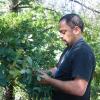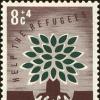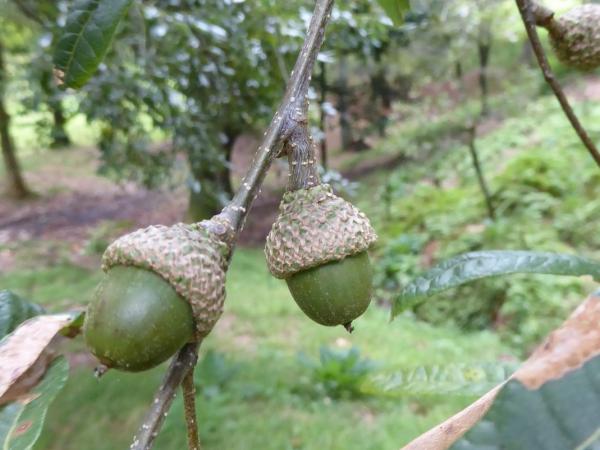Editor's Picks
Plant Focus
Species Spotlight: Quercus tonduzii Seemen
This is my most elusive and desired oak. Since my first trip to Costa Rica in 1993 the location of this rare oak has been an obsession for me, and until now I had not been able to find its ripe acorns.

On my first trip, in August 1993, I lacked information on the characteristics of the Quercus of Central America, many with laurel-like leaves. One of the places I visited was Poás Volcano, a popular destination with visitors to Costa Rica, but due to the absence of acorns on the ground I was unable to identify Quercus tonduzii. On that trip what I did get was our oldest Central American Quercus in the Iturraran Botanical Garden, Q. costaricensis, now over 20 m tall. I was also unsuccessful in my visit to Poás Volcano in 1996: I located some trees on the way from the reception to Laguna Botos, but there were only a few acorns on the ground, destroyed by squirrels. My next visit in 2001 coincided with a tropical storm that came in from the Atlantic that covered the area of Poás Volcano with dense fog throughout my stay, preventing all visibility.

In 2012 I confidently identified Q. tonduzii in several places: the bus parking lot, in the forest by the source of the Achiote River (where it had been described), and at the entrance to Poás Volcano National Park. Again there were no acorns, although that was to be expected as it was very early, in the month of May. Now I know that the acorns ripen in November and December. The next visit was between August and September 2016, the only one on which I was accompanied by my friend Michel Duhart, a regular companion on my collections in Mexico. On this occasion we collected some acorns, but they were not yet ripe and turned out to be non-viable. The last attempt I made was in 2017: unfortunately the Poás Volcano was active and it was forbidden to approach the National Park. Subsequently, the COVID 19 epidemic made travel difficult and since then I have not returned to Costa Rica.

But, finally, we have been able to confirm that Q. tonduzii acorns mature in December, thanks to an Italian friend who traveled to Costa Rica last Christmas and found ripe acorns.

It is possibly the oak with the most restricted distribution in the world. It is only known from the surroundings of the crater of the Poás Volcano, in Costa Rica, located in the Central Volcanic Mountain Range, near the city of Alajuela, between 2,200 and 2,800 m altitude. I myself have searched for it in other possible locations, such as the Brava, Turrialba, or Irazú volcanoes, without success. They are evergreen trees up to 30 m tall, although normally their height is lower due to the difficult conditions in which they are found. It is a typical representative of the cloud forest and is found on volcanic soils. The rainfall on Poás is very abundant, averaging 3,600 mm per year. The average annual temperature ranges between 12 and 15 ºC.

Quercus tonduzii has the smallest leaves of all the Central America oaks. It grows in association with other oaks, such as Q. costaricensis, Q. copeyensis, and Q. benthamii, and other tree and shrub species such as Magnolia poasana, Ocotea mollicella, O. laetevirens, Sciodaphyllum pittieri, Podocarpus oleifolius, Clusia sp., etc.
The species was described by Seemen in Bulletin de l'herbier Boissier, series 2, 4: 656 (1904). The description (in German) states:
Bark of the twigs brown, whitish, pitted. Buds: Gray, sparsely hairy. Leaves short-stalked (petiole up to 0.7 cm long), young leaves with short gray hairs, later glabrous, broadly lanceolate to oblong, up to 11 cm long, 4 cm wide, apex acute, narrowing at base toward petiole, entire (curved wavy margin), same color on both surfaces, glabrous (only young leaves have short, scattered hairs on lower midrib), shiny above, dull below; midrib slightly protruding above, wide and strongly protruding below; lateral veins about 10 pairs, impressed above, protruding below and branched at edge; tertiary venation barely noticeable. Acorns: alone or in pairs, with a very short peduncle or sessile; cupule hemispherical, somewhat conical at the base (particularly in not yet fully developed acorns), 2 cm in diameter and 1 cm high; scales long, ovoid, obtuse, narrowly membranous at the margin, with short thin hairs at the tip and edge; nut broadly ovate, pointed, up to 2.5 cm long, 2 cm in diameter, protruding almost entirely from the cup, the tip with sparse, short hairs.
Costa Rica: Achiote Forest (Poas), 2200 m. alt. (Ad. Tonduz, X. 1896 [sic, the specimen label states XI. 1896], No. 10788)
The description is quite accurate, but it does not indicate the height of the trees, which are not very tall, usually about 15–20 m. It is not correct that the young leaves have short and scattered hairs at the base of the central vein: they are tomentose at first, with a tomentum that easily rubs off, on the upper side and especially on the lower side. I agree with the rest of the description.

William Trelease, in his 1924 publication The American Oaks, includes it in his series Benthamiae (Subgenus Quercus, section Lobatae) together with Q. benthamii. His brief description includes some errors, such as that it can be deciduous (the leaves of Q. tonduzii are evergreen). Cornelius H. Muller described the species in The Central American Species of Quercus, published in 1942 (click here to view his description). William Burger in Flora Costaricensis, published by the Field Museum of Natural History in 1977, offers a more complete description (click here to view it). Contrary to what Burger writes, the species does not lose its leaves before producing new ones. He does, however, mention the floccose pubescence of young leaves. Finally, A.E. Murray in Kalmia 1983 reduced it to a subspecies or variety of Q. seemannii, a species with which it has certain similarities, but clearly differs from due to many morphological details.

Image: Smithsonian Institution
Quercus tonduzii was named in honor of Adolphe Tonduz (1862–1921), a Swiss botanist who was active in Guatemala and Costa Rica and was the first director of the National Herbarium of Costa Rica. He was the first to collect specimens of this species, which were used by Seemen to describe it.












